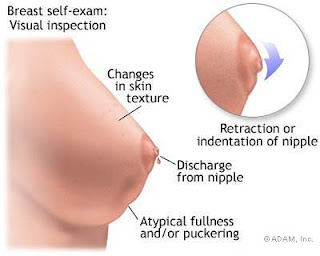Invasive ductal carcinoma (IDC), sometimes called infiltrating ductal carcinoma, is the most common type of breast cancer. About 80% of all breast cancers are invasive ductal carcinomas.
Invasive means that the cancer has “invaded” or spread to the surrounding breast tissues. Ductal means that the cancer began in the milk ducts, which are the “pipes” that carry milk from the milk-producing lobules to the nipple. Carcinoma refers to any cancer that begins in the skin or other tissues that cover internal organs — such as breast tissue. All together, “invasive ductal carcinoma” refers to cancer that has broken through the wall of the milk duct and begun to invade the tissues of the breast. Over time, invasive ductal carcinoma can spread to the lymph nodes and possibly to other areas of the body.
Normal breast with invasive ductal carcinoma (IDC) in an enlarged cross-section of the duct
Breast profile:
A Ducts
B Lobules
C Dilated section of duct to hold milk
D Nipple
E Fat
F Pectoralis major muscle
G Chest wall/rib cage
Enlargement
A Normal duct cell
B Ductal cancer cells breaking through the basement membrane.
C Basement membrane
According to the American Cancer Society, more than 180,000 women in the United States find out they have invasive breast cancer each year. Most of them are diagnosed with invasive ductal carcinoma.
Although invasive ductal carcinoma can affect women at any age, it is more common as women grow older. According to the American Cancer Society, about two-thirds of women are 55 or older when they are diagnosed with an invasive breast cancer. Invasive ductal carcinoma also affects men.
Invasive means that the cancer has “invaded” or spread to the surrounding breast tissues. Ductal means that the cancer began in the milk ducts, which are the “pipes” that carry milk from the milk-producing lobules to the nipple. Carcinoma refers to any cancer that begins in the skin or other tissues that cover internal organs — such as breast tissue. All together, “invasive ductal carcinoma” refers to cancer that has broken through the wall of the milk duct and begun to invade the tissues of the breast. Over time, invasive ductal carcinoma can spread to the lymph nodes and possibly to other areas of the body.
Normal breast with invasive ductal carcinoma (IDC) in an enlarged cross-section of the duct
Breast profile:
A Ducts
B Lobules
C Dilated section of duct to hold milk
D Nipple
E Fat
F Pectoralis major muscle
G Chest wall/rib cage
Enlargement
A Normal duct cell
B Ductal cancer cells breaking through the basement membrane.
C Basement membrane
According to the American Cancer Society, more than 180,000 women in the United States find out they have invasive breast cancer each year. Most of them are diagnosed with invasive ductal carcinoma.
Although invasive ductal carcinoma can affect women at any age, it is more common as women grow older. According to the American Cancer Society, about two-thirds of women are 55 or older when they are diagnosed with an invasive breast cancer. Invasive ductal carcinoma also affects men.














